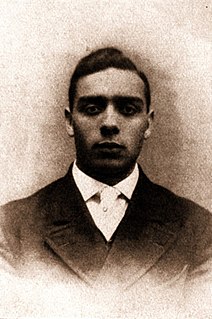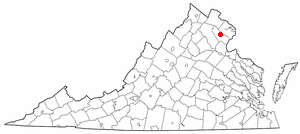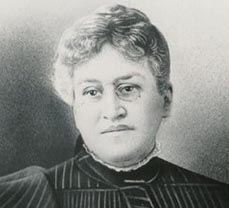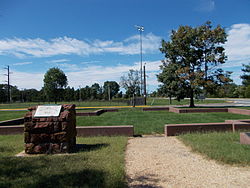
Prince William County is located on the Potomac River in the Commonwealth of Virginia in the United States. As of the 2010 census, the population was 402,002, on July 1, 2018, the population was estimated to be 468,011, making it Virginia's second-most populous county. Its county seat is the independent city of Manassas.

Manassas is an independent city in the Commonwealth of Virginia. As of the 2010 Census, the population was 37,821. The city borders Prince William County, and the independent city of Manassas Park, Virginia. The Bureau of Economic Analysis includes both Manassas and Manassas Park with Prince William County for statistical purposes.
Charles Hamilton Houston was a prominent African-American lawyer, Dean of Howard University Law School, and NAACP first special counsel, or Litigation Director. A graduate of Amherst College and Harvard Law School, Houston played a significant role in dismantling Jim Crow laws, especially attacking segregation in schools and racial housing covenants. He earned the title "The Man Who Killed Jim Crow".

Northern Virginia, locally referred to as NOVA or NoVA, comprises several counties and independent cities in the Commonwealth of Virginia in the United States. It is a widespread region radiating westward and southward from Washington, D.C. With an estimated 3,149,413 residents in 2018, it is the most populous region of Virginia and the Washington metropolitan area.

Northern Virginia Community College is a public community college composed of six campuses and four centers in the Northern Virginia suburbs of Washington, D.C.. Northern Virginia Community College is the second largest multi-campus community college in the United States and the largest educational institution in the Commonwealth of Virginia.

Abiel Smith School, founded in 1835, is a school located at 46 Joy Street in Boston, Massachusetts, United States, adjacent to the African Meeting House. It is named for Abiel Smith, a white philanthropist who left money in his will to the city of Boston for the education of black children.

The Institute for Colored Youth was founded in 1837 in Philadelphia, Pennsylvania, United States. After moving to Delaware County, Pennsylvania, and changing its name to Cheyney University, it continues as the oldest African-American school of higher education, although degrees were not granted by Cheyney until 1913. The second site of the Institute for Colored Youth at Ninth and Bainbridge Streets in Philadelphia was added to the National Register of Historic Places in 1986. It is also known as the Samuel J. Randall School, and is a three-story, three-bay brick building built in 1865, in the Italianate-style

Edwin Bancroft Henderson, was an African-American educator and National Association for the Advancement of Colored People (NAACP) pioneer. The "Father of Black Basketball," introduced basketball to African Americans in Washington, D.C. in 1904, and was Washington's first male African American physical education teacher. From 1926 until his retirement in 1954, Henderson served as director of health and physical education for Washington D.C.'s black schools. An athlete and team player rather than a star, Henderson both taught physical education to African Americans and organized athletic activities in Washington, D.C. and Fairfax County, Virginia, where his grandmother lived and where he returned with his wife in 1910 to raise their family. A prolific letter writer both to newspapers in the Washington D.C. metropolitan area and Alabama, Henderson also helped organize the Fairfax County branch of the NAACP and twice served as President of the Virginia NAACP in the 1950s.

The Robert Russa Moton Museum is a historic site and museum at 900 Griffin Boulevard in Farmville, Prince Edward County, Virginia. It is located in the former Robert Russa Moton High School, considered "the student birthplace of America's Civil Rights Movement" for its initial student strike and ultimate role in the 1954 Brown v. Board of Education case desegregating public schools. It was designated a National Historic Landmark in 1998, and is now a museum dedicated to that history. The museum were named for African-American educator Robert Russa Moton.

Criser High School was an African American school accommodating grades 1-12 constructed in 1959 in the Northern Virginia town of Front Royal, Virginia. Its opening occurred the same year 22 African American students integrated the all-white Warren County High School which drew national media attention.

Black schools, also referred to as "colored" schools, were racially segregated schools in the United States that originated after the American Civil War and Reconstruction era. The phenomenon began shortly after the Reconstruction era when Southern states created public policies, otherwise known as Jim Crow laws, that legalized the practice of racial segregation to keep races separated and maintain white supremacy. In the United States white opposition to African-American success resulted in only the most rudimentary schools for African Americans, as proven by Gebhart v. Belton, lacking necessary state funding. It often took decades after the South established public schools for systems to offer education at the high school level.

This is a list of the National Register of Historic Places listings in Manassas, Virginia.

The Bordentown School, was a residential high school for African-American students, located in Bordentown in Burlington County, New Jersey, United States. Operated for most of the time as a publicly financed co-ed boarding school for African-American children, it was known as the "Tuskegee of the North" for its adoption of many of the educational practices first developed at the Tuskegee Institute in Alabama. The school closed down in 1955.

Carver High School was a segregated high school in Phoenix, Arizona.

Dunbar School is a historic school building located in Fairmont, Marion County, West Virginia. It was built in 1928, and the first classes were held in January 1929. The school was added to the National Register of Historic Places in 2015.

Jane Serepta Dean was born into slavery in northern Virginia, freed as a result of the American Civil War, and became an important founder of churches and Sunday Schools for African Americans in northern Virginia. Dean founded the Manassas Industrial School for Colored Youth, which for more than four decades was the only institution of secondary education available to African American youth in Northern Virginia, and one of only two in the state without overt religious affiliation.

Fannie M. Richards (1840-1922) was an American educator. She created the first kindergarten program in Michigan, and for that was inducted into the Michigan Women's Hall of Fame.

Manassas Regional High School was a segregated public school for black students that existed from 1938 until 1966 in Manassas, Virginia. It served black students from Prince William, Warren, Fauquier, and Fairfax counties.

George Carr Round was a Union soldier who settled in Prince William County, Virginia after the American Civil War, where he became a lawyer, superintendent of public instruction in Manassas, Virginia and served a term in the Virginia General Assembly. Although Round donated the land for a more-accessible courthouse, organized the first public schools in the area and secured funding for the county's first public library, he became known nationally in his lifetime for organizing the Manassas Peace Jubilee in 1911, alongside fellow one-term delegate Edmund Berkeley and for contributing to the creation of Manassas National Battlefield Park decades after his death.

The Ashburn Colored School is a former one-room schoolhouse for black students located at 20593 Ashburn Road in Ashburn, Virginia. Constructed in the late 19th century, it was in use until 1958. In the 21st century it has been restored after being dilapidated and vandalized.























